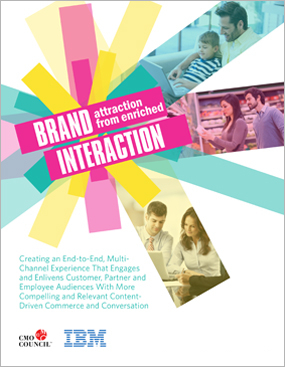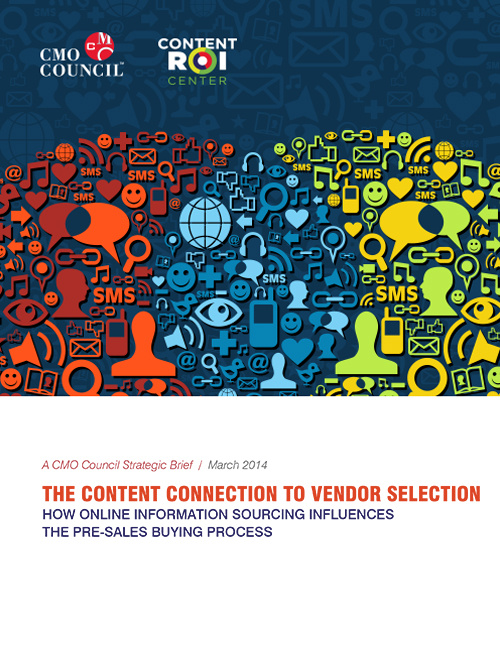Making Content Grow Into Customer Flow
Content marketers face challenges on multiple fronts — and they’re losing the battle. More
Leveraging the power of content to drive business opportunities and grow brand presence
Digital content is the key to engagement in today's connected marketplace. According to Cision, content marketing exceeded $300 billion in 2019. According to a survey by the Content Marketing Institute, most successful B2B marketers spend 40 percent of their budgets on content marketing. Meanwhile, the rapid proliferation of digital channels and formats — along with the insatiable appetite of customers in every market for fresh and relevant content — is pushing marketers to invest even more.
The CMO Council's Content ROI Center is dedicated to advancing the discipline of content marketing. We are a go-to source of thought leadership, insight and services to help marketers more fully leverage the power of content to drive business opportunities, influence purchasing decisions, and grow brand presence.
The Center is working with marketing leaders and experts around the world to develop advanced practices, identify best-in-class tools and resources, and create more compelling and strategic thought leadership and creative content campaigns. The Council offers a variety of strategic consulting, creative and outsourcing services designed to help marketing organizations optimize the way they develop, deliver and promote digital content to engage customer markets. (See here)
Among CMO Council research insights that underscore the problems and shortcomings in current content marketing initiatives:
The ROI Center provides commentary and advice on the top 10 essentials for effective authority leadership-driven content marketing:
Content Services and Sponsorship Opportunities
To start a conversation about our Content ROI Services and learn more about sponsorship opportunities:
Email Bryan DeRose (bderose@cmocouncil.org) or call him 1-408-677-5330
CMO COUNCIL RESEARCH ON CONTENT MARKETING EFFECTIVENESS
BRINGING NEW COMPLIANCE TO LEAD MARKETING SCIENCE
According to a new Chief Marketing Officer (CMO) Council report, “Are Garbage Leads Trashing Your Brand?”, marketers are now rethinking their lead generation strategies, techniques and sources to ensure better lead compliance and brand trust. New demands for marketing accountability and responsibility require structured opt-in and permission-based, legally compliant processes from third-party lead gen providers.
According to the CMO Council, the problem with questionable lead sourcing practices is getting worse by the day. A recent study from The Leads Council found that 47.1 percent of marketers believe lead quality from third-party lead gen campaigns is declining. They complain that leads are being oversold, with some questioning the ethics behind lead collection. Even worse, irresponsible lead gen providers can drag unsuspecting brands into legal hot water.
Truth is, B2B marketers rushing to acquire mass leads at the cheapest price have created the problem, notes the CMO Council. They’ve helped spawn a lead gen market full of bad actors, or at least bad practices that mock governance around lead compliance, lead capture, lead verification and lead qualification. As marketers continue to pour dollars into audience data acquisition — the market grew 17.7 percent last year to $11.9 billion — expect more bad behavior.
BRAND ATTRACTION FROM ENRICHED INTERACTION
A survey report by the CMO Council—entitled “Brand Attraction from Enriched Interaction”—reveals marketers still lag in creating multi-channel, digital marketing campaigns that reach and resonate with diverse, micro-audiences worldwide. Only 19 percent said they are extremely good or very good in this area. In contrast, 45 percent gave lackluster grades on their ability to captivate and engage customers, partners and employees through fully integrated mobile, web and social channels. This compares to just 21 percent who said they were very proficient.
The study was designed to assess the degree to which marketers are embracing new digital channels and content management technologies to realize the full value of rich media engagement, crowd-sourced content, and mass-customized commerce through higher levels of personalization and tailored interaction. Most notably, the study reveals that only 5 percent of respondents have highly, or tightly integrated, content and commerce compared to 64 percent who say they have plans or existing programs to improve this.
A second CMO Council study entitled “From Content to Creativity: The Role of Visual Media in Impactful Brand Storytelling,” reveals that marketers believe visual assets -- including photography, illustrations, infographics and videos -- are core to customer engagement and will increase in usage. Video will most dramatically increase in importance in the near future, according to 79 percent of senior marketers. Infographics (60 percent), photographs (50 percent), and illustrations (41 percent) will also increase in usage.
LEAD FLOW THAT HELPS YOU GROW
A detailed study from the CMO Council and the Content ROI Center finds most companies are struggling to originate compelling thought leadership content that engages the right customer decision makers and produces quality lead flow that can advance sales performance. Not only do marketers lack unanimity on what constitutes an actual sales lead, but they also are not teaming effectively with sales and business development groups. In most cases, these internal stakeholders lack synergy and alignment around demand generation strategies, themes and advocacy agendas.
Entitled “Lead Flow That Helps You Grow,” the North America-based research found:
While 75 percent of marketers view the number of downloads or registrations as the most important measure of content marketing success, they admit to many key failings that impact this metric. The top five include not:
THE CONTENT CONNECTION TO VENDOR SELECTION
CMO Council research—entitled “The Content Connection to Vendor Selection”—provides insights into how different types of marketing content impact critical phases of vendor identification, qualification and consideration, as well as the path to selection and purchase.
The research found that content downloaded from trusted sources on the Internet was essential to pre-sales discovery, qualification and selection of vendors. It also showed that the sourcing, sharing and consumption of content occurred mostly among three types of informally structured buying groups within enterprise organizations.
According to the CMO Council, B2B marketers annually invest an estimated $16.6 billion in digital content publishing to acquire business leads, influence customer specification and consideration, as well as educate and engage prospects. Despite spending about 25 percent of their marketing budgets on content creation, the CMO Council notes most companies lack the necessary strategies, competencies and best practices to effectively engage their markets, and very few have content performance metrics in place to measure effectiveness and calculate ROI.
The study validates earlier CMO Council research that revealed 88 percent of 400 business buyers believe online content plays a major to moderate role in vendor selection, yet just nine percent of respondents think of vendors as trusted sources of content. Furthermore, CMO Council studies show that the most influential types of content across both the awareness and evaluation phases of the buying journey are third-party validated research reports and studies.
BETTER LEAD YIELD IN THE CONTENT MARKETING FIELD
Early CMO Council research reveals that business buyers give vendors poor marks for the value and trustworthiness of their online content, rating content produced by professional organizations and industry groups as more usable and relevant.
The report—entitled “Better Lead Yield in the Content Marketing Field”—looks at the critical need for marketing organizations to bring more discipline and strategic thinking to content specification, delivery and analytics.
Despite spending about 25 percent of their marketing budgets on content creation, most companies lack the necessary strategies, competencies and best practices to effectively engage their markets. And very few have content performance measures and metrics in place to scorecard effectiveness and calculate ROI.
According to the CMO Council’s report, organizations need to have well-conceived, customer-centric themes and subject areas, strong content origination capabilities and partnerships, more effective delivery networks, and measurable content performance tracking systems.
DEFINE WHAT’S VALUED ONLINE
A milestone CMO Council online survey, entitled “Define What’s Valued Online,” gained insights from more than 400 business buyers across a wide range of industries and functional areas worldwide. It clearly evidenced that online content plays an essential role in influencing Bt2B purchasing decisions.
The survey revealed:

This report reveals that marketers still lag in creating multi-channel, digital marketing campaigns that reach and resonate with diverse, micro-audiences worldwide. Only 19 percent said they are extremely good or very good in this area. In contrast, ... More

Content marketing research by the Chief Marketing Officer (CMO) Council reveals insight-hungry business buyers are increasingly reliant on trusted third-party information to make more educated decisions. The study also found that buyers tend to be ... More